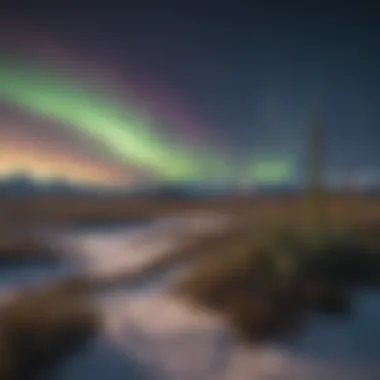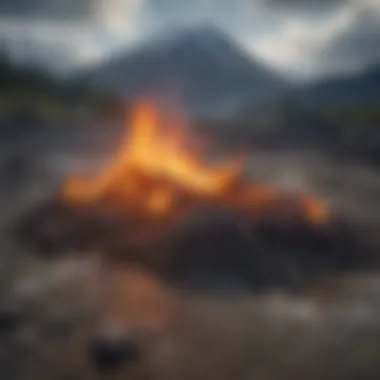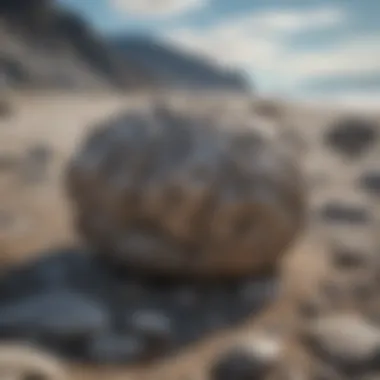Unveiling Alaska's Geological Marvels: A Geologist's Expose


Rock and Fossil Identification
Alaska's rugged terrain is a treasure trove for geologists and rock collectors alike. In this vast and untamed landscape, a diverse range of rocks and fossils lie waiting to be discovered. From rare minerals like gold and jade to ancient fossils preserved in layers of sedimentary rock, each specimen tells a unique story of the Earth's history. Recognizing the different types of rocks and fossils is crucial for enthusiasts to unearth these geological treasures.
- Types of rocks and fossils: Alaska boasts a multitude of rock types, including igneous, sedimentary, and metamorphic rocks. Fossils found in the state range from prehistoric plant remains to marine life fossils.
- Characteristics to look for: Identifying rocks and fossils requires a keen eye for detail. Factors such as color, texture, hardness, and crystal structure can provide clues about the specimen's composition and origin.
- Tools for identification: Geologists often rely on tools such as hammers, chisels, magnifying glasses, and even geologic hammers to assist in the identification and extraction of rocks and fossils.
Introduction
In the vast expanse of Alaska's rugged terrain lies a hidden world of geological wonders waiting to be discovered. This article serves as a comprehensive guide for rock and fossil enthusiasts, offering insights into the rich tapestry of materials just beneath the surface. From rare minerals to ancient fossils, Alaska's pay dirt holds a myriad of treasures that beckon explorers to delve deep into the earth's history and uncover its secrets.
Exploring Alaska's Geological Riches
The Unique Geological Landscape of Alaska
Alaska boasts a geological landscape unlike any other, characterized by its diverse terrain shaped by millions of years of tectonic activity. From towering mountain ranges to expansive glaciers, the unique geology of Alaska provides a fertile ground for mineral deposits and fossil preservation. This section explores the distinct features of Alaska's geological landscape, delving into the geological processes that have contributed to the formation of its remarkable terrain.
Impact of Glaciers on Alaska's Geological Formation
The influence of glaciers on Alaska's geological formation cannot be overstated. These massive ice sheets have sculpted the land, leaving behind a mosaic of valleys, fjords, and moraines. The interaction between glaciers and the underlying rock has led to the creation of unique geological formations, making Alaska a prime destination for studying glacial geology. Understanding the impact of glaciers is crucial for appreciating the geologic history of Alaska and unraveling the mysteries hidden within its icy embrace.
Significance of Alaska's Pay Dirt
The Allure of Rare Minerals
Alaska's pay dirt is renowned for its abundance of rare minerals that captivate collectors and geologists alike. From shimmering quartz crystals to iridescent opals, Alaska offers a treasure trove of mineral diversity waiting to be uncovered. This section delves into the allure of rare minerals found in Alaska, highlighting their unique properties and the geological processes that have shaped them over time.
Unearthing Ancient Fossils
The ancient landscapes of Alaska hold a rich fossil record, documenting the diverse flora and fauna that once inhabited this untamed wilderness. Unearthing ancient fossils provides a glimpse into prehistoric ecosystems and the evolution of life on Earth. This section explores the significance of fossil discoveries in Alaska, showcasing the important contributions they make to our understanding of the planet's history and the interconnectedness of life throughout the ages.


Alaska's Geological Marvels
Alaska's Geological Marvels play a crucial role in unraveling the rich geological tapestry of the Last Frontier, setting the stage for a profound exploration of the state's diverse and captivating landscapes. This section delves into the intricacies of Alaska's geological wonders, shedding light on the unique features and phenomena that make it a hotspot for mineral and fossil enthusiasts.
Mineral Exploration in Alaska
Top Minerals Found in Alaska
Exploring the Top Minerals Found in Alaska unveils a treasure trove of resources that hold significant value in the realm of geology. From renowned gold deposits to prized jade and copper reserves, Alaska's mineral wealth exerts a magnetic pull on mining endeavors and collectors alike. The top minerals reflect the state's geological richness and contribute to its standing as a prominent mineral destination. Their distinct characteristics, such as exceptional luster or rarity, enhance their appeal to enthusiasts and researchers seeking to uncover the geological secrets of Alaska.
Challenges of Mining in Alaska
Unveiling the Challenges of Mining in Alaska underscores the complex interplay between natural resources, environmental conservation, and economic interests. Navigating the rugged terrain and unpredictable weather conditions poses formidable obstacles to mining operations, necessitating innovative solutions and sustainable practices. Environmental concerns, including habitat preservation and waste management, underscore the delicate balance required in extracting minerals from Alaska's pristine landscapes. By addressing these challenges, the mining industry can harness Alaska's mineral potential while safeguarding its natural heritage.
Fossil Discoveries in Alaska
Impactful Fossil Finds in Alaska
Delving into the Impactful Fossil Finds in Alaska unravels a prehistoric narrative teeming with ancient life forms and paleontological marvels. From towering mammoths to enigmatic marine reptiles, Alaska's fossil record offers a window into the past, shaping our understanding of evolution and ecological dynamics. Each fossil discovery represents a snapshot of Alaska's ancient ecosystems, sparking awe and curiosity among researchers and fossil enthusiasts eager to piece together the state's geological history.
Preserving Alaska's Paleontological Treasures
Preserving Alaska's Paleontological Treasures safeguards the legacy of paleontological discoveries for future generations, underscoring the importance of conservation efforts in the face of ongoing environmental changes. By implementing rigorous preservation techniques and ethical collection practices, researchers and museums ensure the integrity and scientific value of Alaska's paleontological heritage. Balancing scientific inquiry with conservation imperatives, preserving paleontological treasures is essential for advancing knowledge and fostering appreciation for Alaska's geological legacy.
Volcanic Activity and Landform Formation
The Ring of Fire: Alaska's Volcanic Belt
Exploring The Ring of Fire: Alaska's Volcanic Belt unveils a dynamic landscape shaped by volcanic activity, with a string of volcanoes spanning the state's rugged terrain. Alaska's volcanic belt not only fuels geothermal energy production but also influences landform formation and geological processes. The volcanic belt's distinctive features, including stratovolcanoes and calderas, highlight the state's ongoing volcanic activity and geological significance, offering a glimpse into Earth's tumultuous geologic history.


Geological Features Shaped by Volcanic Eruptions
Examining Geological Features Shaped by Volcanic Eruptions sheds light on the transformative impact of volcanic events on Alaska's topography and geology. From steaming fumaroles to expansive lava fields, Alaska's volcanic eruptions sculpt landforms that bear witness to nature's raw power and creative force. While volcanic eruptions pose challenges in terms of environmental resilience and hazard mitigation, they also contribute to the state's geological diversity and scientific allure, inviting exploration and study of these extraordinary geological phenomena.
Rockhounding in Alaska
Rockhounding in Alaska holds a significant place in the context of this article as it offers rock and fossil collectors a unique opportunity to explore the diverse geological landscape of the Last Frontier. The practice of rockhounding involves searching for valuable minerals, gemstones, and fossils in their natural surroundings, providing enthusiasts with an enriching and hands-on experience. Conducting rockhounding activities in Alaska not only allows collectors to discover rare specimens but also contributes to the scientific understanding of the region's geological history.
Popular Rockhounding Sites
Kodiak Island: A Gemstone Haven
Kodiak Island stands out as a gemstone haven within the landscape of Alaska, boasting a rich variety of precious stones waiting to be unearthed by dedicated rockhounds. The island's geological composition presents a diverse range of gemstones such as agates, jaspers, and fossilized wood, making it a prime destination for collectors seeking unique specimens. The accessibility of these gemstones on Kodiak Island, coupled with its picturesque natural beauty, adds to the allure of this location for aspiring and experienced rockhounds alike.
Valdez: Hunting for Agates
Valdez offers a remarkable opportunity for rockhounds to hunt for agates, semi-precious stones known for their colorful and banded varieties. The region's rivers and beaches are known for yielding stunning agates, ranging from milky white to vibrant red hues, providing collectors with an exciting treasure-hunting experience. This pursuit of agates in Valdez not only offers enthusiasts the chance to build their collections but also showcases the natural beauty and diversity of Alaska's geological treasures.
Tips for Successful Rockhounding
Essential Equipment for Rockhounding
Having the right equipment is essential for a successful rockhounding expedition in Alaska. Necessary tools such as rock hammers, chisels, magnifying glasses, and sturdy footwear are crucial for effective specimen retrieval and safe exploration. Additionally, specialized equipment like UV lights for detecting fluorescent minerals can enhance the rockhounding experience, enabling collectors to identify hidden treasures with precision.
Ethical Considerations in Collecting
Ethical considerations play a pivotal role in rockhounding practices in Alaska, emphasizing the importance of respecting natural environments and adhering to legal regulations. Collectors are encouraged to obtain necessary permits for collecting in certain areas, practice sustainable collection methods, and prioritize the preservation of specimens for future generations. By promoting ethical conduct in rockhounding activities, enthusiasts can contribute to the conservation of Alaska's geological resources while engaging in a fulfilling and responsible hobby.
Preservation and Collection Techniques


In the realm of geology and rock/fossil collection, Preservation and Collection Techniques play a pivotal role in ensuring the longevity and quality of specimens gathered during expeditions. Within the context of this comprehensive guide on Unearthing Alaska's Pay Dirt, the significance of Preservation and Collection Techniques cannot be overstated. By employing proper techniques, enthusiasts and geologists can maintain the integrity of their findings for future study and appreciation.
Ensuring the Longevity of Specimens
Proper Storage Methods
Proper Storage Methods are fundamental in safeguarding specimens from deterioration and damage. In this article, the focus on Proper Storage Methods stems from their ability to protect fossils and minerals from environmental factors such as humidity and temperature fluctuations. The key characteristic of Proper Storage Methods lies in providing a controlled environment that mimics the natural conditions required to preserve specimens effectively. This method is a popular choice for rock and fossil collectors due to its proven track record in maintaining specimen quality over extended periods. The unique feature of Proper Storage Methods is their adaptability to different specimen types, ensuring each artifact receives the necessary care customized to its preservation needs.
Cleaning and Maintenance Tips
Cleaning and Maintenance Tips are essential practices that contribute to the overall preservation and presentation of collected specimens. In the context of this guide, these tips aid collectors in ensuring that their fossils and minerals retain their original allure and characteristics. The key characteristic of Cleaning and Maintenance Tips is their ability to remove debris and contaminants without causing harm to the specimen's surface. This method is a beneficial choice for this article as it emphasizes the importance of regular upkeep to prevent degradation. One unique feature of Cleaning and Maintenance Tips is their capacity to enhance the aesthetic appeal of specimens while prolonging their lifespan. By incorporating these tips, collectors can showcase their treasures in pristine condition while retaining crucial scientific information embedded within the specimens.
Documentation and Cataloging
Importance of Record-Keeping
The integral aspect of Importance of Record-Keeping is its contribution to preserving the history and provenance of collected specimens. In the domain of Unearthing Alaska's Pay Dirt, record-keeping serves as a vital tool for tracking the origins and handling of each fossil or mineral discovered. The key characteristic of Importance of Record-Keeping lies in its ability to establish a chronological record that aids in scientific research and specimen authentication. This practice is a popular choice for this article as it adds credibility to the artifacts found, strengthening their scientific value. One unique feature of Importance of Record-Keeping is its role in creating a comprehensive archive that can be referenced for future studies, allowing for a deeper understanding of Alaska's geological richness.
Organizing Your Collection
Organizing Your Collection is imperative for maintaining an efficient and structured repository of specimens. Within the context of this geologist's guide, the emphasis on organizing one's collection revolves around facilitating easy access and retrieval of specific fossils and minerals. The key characteristic of Organizing Your Collection is its capacity to categorize specimens based on various criteria such as type, location, and geological era, enabling collectors to showcase their treasures systematically. This method is a beneficial choice for this article as it promotes a systematic approach to collection management, enhancing both the aesthetic and scientific value of the artifacts. One unique feature of Organizing Your Collection is its ability to showcase the diversity and uniqueness of Alaska's geological treasures, providing a glimpse into the state's rich natural history.
Conclusion
In the culmination of this comprehensive guide on Unearthing Alaska's Pay Dirt, it becomes evident that the importance of the conclusion extends beyond just summarizing key elements. The conclusion serves as the anchor that ties together the diverse facets explored throughout the article, offering insight into the significance of geological exploration in Alaska's rugged terrain. Highlighting the essence of the topic, the conclusion encapsulates the essence of discovery and preservation, emphasizing the thrill of finding rare minerals and ancient fossils while underscoring the need to continue the geologic exploration for future generations of enthusiasts. It reiterates the allure of Alaska's geological marvels and underscores the responsibility of enthusiasts to uphold ethical principles in rock and fossil collection, ensuring the preservation of these natural wonders for years to come.
Unveiling Alaska's Pay Dirt Secrets
The Thrill of Discovery
Delving into the specific aspect of The Thrill of Discovery unveils a captivating journey of exploration and enlightenment for rock and fossil collectors. This section encapsulates the exhilarating quest for uncovering rare minerals and ancient fossils hidden within Alaska's rugged terrain. The key characteristic of The Thrill of Discovery lies in the inherent excitement and anticipation that each expedition brings, making it a popular and sought-after experience for enthusiasts featured in this article. The unique feature of The Thrill of Discovery is its ability to connect individuals with the raw beauty of nature, instilling a sense of awe and wonder as each precious find is unearthed. While the thrill of discovery offers unmatched excitement, it also comes with a responsibility to ensure sustainable practices in geological exploration, aligning with the overarching theme of preservation and conservation emphasized throughout this guide.
Continuing the Geologic Exploration
Continuing the Geologic Exploration underscores the journey's continuity in the quest for uncovering Alaska's geological wonders. This vital aspect contributes to the persistence of geologic research and discovery, pushing the boundaries of knowledge and understanding in the field of rock and fossil collection. The key characteristic of Continuing the Geologic Exploration is its role in fostering a sense of curiosity and discovery among enthusiasts, encouraging ongoing exploration and study of Alaska's diverse geological landscape. This choice is beneficial for the article as it emphasizes the ever-evolving nature of geological exploration, portraying it as a dynamic and evolving field that offers endless opportunities for discovery and learning. With a focus on scientific advancement and exploration, Continuing the Geologic Exploration stands as a cornerstone for future endeavors in uncovering the mysteries hidden within Alaska's pay dirt, paving the way for new insights and discoveries to unfold.







